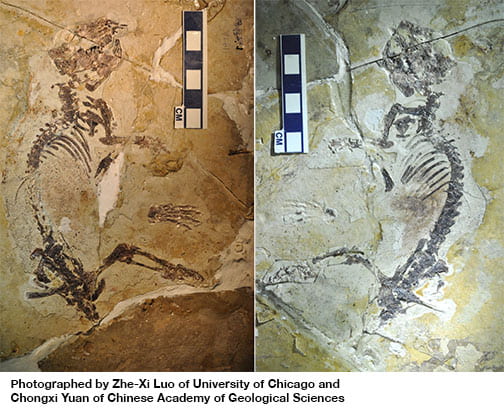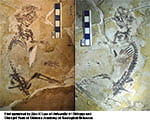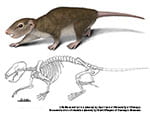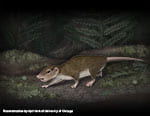Press Release
A new Jurassic fossil from China provides fresh evidence of early mammal evolution
By Kevin Jiang
The evolutionary origins of multituberculates, the most successful group of ancient mammals, are now illuminated with the discovery of a 160 million-year-old fossil. A fast-running, agile omnivore similar to a modern-day African dormouse, Rugosodon eurasiaticus represents the earliest complete fossil of the multituberculates. Its features were described by scientists from the University of Chicago on Aug. 16 in Science.
While the extinction of the dinosaurs 66 million years ago marked the beginning of the age of the mammals, early mammalian species were flourishing long before. Of these ancestral groups, the most successful were the multituberculates, mammals characterized by numerous tiny bumps or cusps on their back teeth. Occupying similar environmental niches to modern rodents, multituberculates possessed a continuous fossil record from around 170 million years ago until their extinction around 35 million years ago. They lived and thrived alongside the dinosaurs for more than 100 million years, and outlived them by another 30 million years.
“Despite the success of the multituberculates, the earliest fossils are very fragmentary. Now, we finally have a complete skeletal fossil that allows us to paint a coherent picture of the evolutionary origin of these prolific and important ancient mammals,” said Zhe-Xi Luo, PhD, professor of organismal biology and anatomy at the University of Chicago.
Discovered by Luo and his team in the Liaoning Province of China, the fossil of Rugosodon eurasiaticus reveals key adaptations that allowed multituberculates to be the most abundant mammal during the Mesozoic Era.
Of particular note are its surprisingly mobile and flexible anklebones, which suggest that Rugosodon was a fast-running and agile mammal that mostly lived on the ground. This skeletal feature is thought to be anatomical basis for the versatile and diverse locomotor adaptations, ranging from tree climbing to tunnel digging, that later multituberculates possessed.
Rugosodon draws its name from its rugose teeth, which were ornamented by numerous ridges and wrinkles. Its dental features are evidence that it was a versatile omnivore that fed on the leaves and seeds of gymnosperm plants and ferns, as well as worms and insects. Interestingly, this indicates that the later rise of numerous herbivorous multituberculates originated from an omnivorous ancestor.
Likely a nocturnal mammal, Rugosodon’s estimated body mass and feeding habits are analogous to a modern day African dormouse, and it is thought to have lived on lakeshores in what is now western Liaoning Province of China. Scattered fossil teeth of multituberculates similar to Rugosodon have been discovered as far away as Western Europe. Thus, this new fossil provides fresh evidence that mammals in Europe and Asia had extensive interchanges during the Jurassic Era.
“Essentially, multituberculates were the first important mammal group to occupy an herbivorous niche; they were able to exploit a part of the ecosystem that was not accessible to many other vertebrates including other Mesozoic mammals,” Luo said. “This superb feeding function, together with versatile locomotor adaptions, explains why multituberculates were so successful and diverse. Now we have a sense of what they started off with, thanks to the discovery of Rugosodon.”
The fossil of Rugosodon, now deposited in the collections of the Beijing Museum of Natural History, was studied by scientists from Chinese Academy of Geological Sciences, Beijing Museum of Natural History, and the University of Chicago. The research was supported by the Ministry of Science and Technology of China, Ministry of Land Resources of China, Beijing Municipal Science & Technology Commission, National Science Foundation and the University of Chicago.
Authors and Contacts
Chong-Xi Yuan
Institute of Geology, Chinese Academy of Geological Sciences
Beijing, China
yuanchongxi@cags.net.cn
Qiang Ji
Institute of Geology, Chinese Academy of Geological Sciences
Beijing, China
jirod@cags.net.cn
Qing-Jin Meng
Beijing Museum of Natural History
Beijing, China
mengqingjin@bmnh.org.cn
Alan R. Tabrum
Section of Vertebrate Paleontology, Carnegie Museum of Natural History
Pittsburge, PA
tabruma@carnegiemnh.org
Zhe-Xi Luo
Department of Organismal Biology and Anatomy, University of Chicago
Chicago, IL
773.702.7816
zxluo@uchicago.edu
Images
Attention: Artwork and photographs downloaded from here are for media use only. High resolution images available from April Neander at aisch@uchicago.edu.





